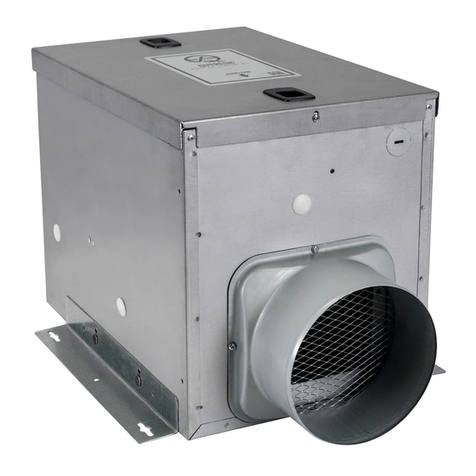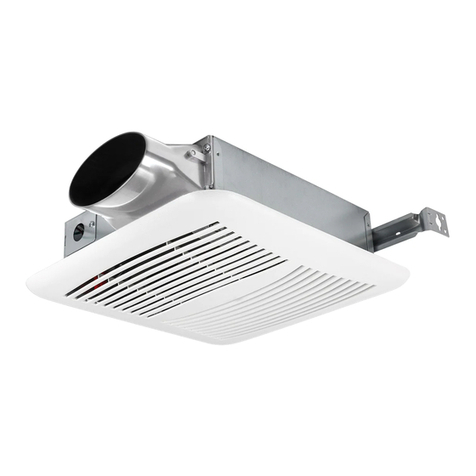4. Connect the ducting to the fan’s duct collar. Seal ducting with appropriately rated tape. Use suitable
clamps to secure ducting in place. Make sure the fresh air intake is connected to a properly installed
intake port that is a suitable weather hood with insect screen to protect air intake. It is recommended that
low restriction termination fittings be used.
5. Ensure duct joints and exterior penetrations are sealed with caulk or other similar material to create an
air-tight path to minimize building heat loss or gain and to reduce the potential for condensation.
Place/wrap insulation around duct and/or fan in order to minimize possible condensation buildup within
the duct, as well as building heat loss or gain.
NOTE: At the base of the inlet duct adapter, there is a small diameter test port hole covered with a
rubber cap. Make sure the test port is not covered up with the ducting so that it can be accessed for pitot
tube testing. To access the port, remove the port cover and insert a pitot tube.
Optional Air Filter
An air filter (available separately) can be added to this unit to provide additional filtration of the intake air.
The unit will accept a nominal 10” x 10” x 2” filter.
1. Release the toggle latch securing the cover in place and open the cover
2. Squeeze and remove the spring that secures the insect filter in place.
3. Slide the filter into the slot in the housing. Make sure the filter is seated to the bottom of the housing.
4. Squeeze the spring and re-engage the spring, close the cover
and tighten the toggle latch.
ELECTRICAL CONNECTIONS
1. Remove the screw and place the wiring plate in a secure place.
2. Run 120 VAC house wiring to the location of the fan. Use only UL-
approved connectors (not included) to attach the house wiring to the
wiring plate. Refer to the wiring diagram, and connect the wires as
shown.
3. Carefully tuck wires back inside wiring plate and replace wiring
plate securing with the screw that was removed.
WARRANTY
QuFresh warrants this product to be free from defects in materials and workmanship for a period of one
year from the date of purchase. Warranty does not apply to product which fails due to abuse, misuse,
incorrect installation or improper maintenance. During the one-year warranty period, QuFresh will repair
or replace, at its option, any product or part which has a factory defect in workmanship or materials.
The foregoing shall constitute our sole and exclusive warranty and our sole and exclusive liability, and is
in lieu of any other warranties, whether written, oral, implied or statutory. Under no circumstances will
QuFresh be liable for incidental or consequential damages occurring in connection with the use or
performance of the product or other indirect damages with respect to loss of profits, revenue or property
or cost of removal, installation or reinstallation.
Some jurisdictions do not allow the exclusion or limitation of incidental or consequential damages and
some states do not allow limitations on how long an implied warranty lasts, so the above exclusions may
not apply to you.
This warranty gives you specific legal rights and you may have other rights which vary from state to state
and province to province.























